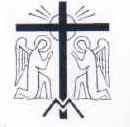Canons Regular of the Holy Cross of Coimbra
| Canons Regular of the Holy Cross of Coimbra | |
|---|---|
 The emblem of the order | |
| Monasteries | 12 |
| Liturgy | Sacrosanctum Concilium |
| Founder | Theotonius of Coimbra |
| Origin | 1131 |
| Recognition | May 5, 1135 |
The Canons Regular of the Holy Cross of Coimbra (abbreviated ORC) are a
History
The Canons Regular of the Holy Cross of
Besides offering the sacred liturgy and pastoral work, the canons wrote historical works on Portugal and translated medical works from Arabic.[2] Eventually all the various regional communities of canons regular in Portugal came to be a part of this Order.[4]
Evangelization
The Order of the Holy Cross were entrusted with the mission of the re-evangelization of the territories reclaimed from the Moors.
In 1136 Theotonius sent a group of the Canons to the Church of Our Lady of Sorrows in the area of Leiria, Portugal. Four years later, the Moors besieged the Castle of Leiria. The Canons were captured and killed. During this same year Theotonius is said to have consecrated Portugal to the Archangel Michael. In 1154 Dom Pedro and Dom Alfonso and their companions were martyred in Morocco. In 1158 the Monastery of the Holy Martyr Romanus was burned by the Moors; the community of eight canons and their Prior perished.[5]
Suppression
Over time struggles between the bishops and various houses and internal dissension among the houses grew. Attempts at reform were made sporadically throughout the 15th and early 16th centuries, the result of which was the suppression or transference of many canonical houses to other orders. By the end of the 18th century, the congregation had slipped into decadence, several houses had been suppressed and in 1791 the Commission to Examine Religious Orders closed almost all novitiates in Portugal. The French invasion and occupation of Portugal (1807–11) left the canons further diminished.[2] However they held on for a few more years until the decree of final dissolution in 1834 by the Portuguese government.
Revival
In 1977, a movement called the Work of the Holy Angels began to work to restore the Order, which was approved in 1979 by Pope John Paul II.[4] The letters "O.R.C."' represent membership in this Order.
In 1993, the Brazilian priest Frederico Cunha was found guilty of the murder in
Notable members
- Athanasius Schneider, Auxiliary Bishop of Astana, Kazakhstan
- João Pereira Venâncio, Former Bishop of Leiria-Fátima, Portugal
Footnotes
- ^ "Peculiar" was truly Dom Juan's last name according to the references used for this article; it is not an editorial mistake
- ^ a b c ""Houses and Congregations", Augustinian Canons". Archived from the original on 2008-10-09. Retrieved 2008-03-19.
- ^ Keogh, William. "St. Charles Borromeo." The Catholic Encyclopedia. Vol. 3. New York: Robert Appleton Company, 1908. 11 Jan. 2015
- ^ a b ""History", Order of the Canons Regular of the Holy Cross". Archived from the original on 2013-09-03. Retrieved 2010-05-09.
- ^ a b c "History of the Order of the Holy Cross", Opus Sanctorum Angelorum
- ^ a b Manuel Catarino, "Os pecados mortais do padre Frederico" in Correio da Manhã, 6 May 2006. Archived 12 of December 2013, retrieved 23 October 2018
- ^ a b Carlos Diogo Santos, "A nova vida do padre Frederico" in Sol, 24 July 2015. Retrieved 25 August 2019]
- Folha de S. Paulo, 10 April 1998. Retrieved 23 October 2018
- ^ Miguel Fernandes Luís: "Padre Frederico escapa ao castigo" Archived 2018-03-08 at the Wayback Machine in Diário de Notícias, 4 March 2018. Retrieved 22 October 2018
